Ecological Adaptation and Sustainable Cultivation of Citrus reticulata by Applying Mixed Design Principles under Changing Climate in China
Abstract
1. Introduction
2. Materials and Methods
2.1. Study Area
2.2. Data Collection and Screening
2.3. Model Construction and Accuracy Evaluation
2.4. Changes in Potential Suitable Area and Centroid Migration
2.5. Methodological Roadmap
3. Results
3.1. Assessment of Model Accuracy
3.2. Dominant Variables Affecting the Potential Distribution of Contemporary C. reticulata, L. chinensis, P. granatum, and L. chinense
3.3. Spatial and Temporal Patterns of Potential Suitable Area for C. reticulata, L. chinensis, P. granatum, and L. chinense
3.4. Potential Shared Habitat Area for C. reticulata, L. chinensis, P. granatum, and L. chinense under Different Climate Emission Scenarios
3.5. Centroid Migration Processes in C. reticulata, L. chinensis, P. granatum, and L. chinense under Different Climate Scenarios
4. Discussion
4.1. Advantages of the MaxEnt Model
4.2. Exploring Crucial Climatic Variables for Optimal Growth in Current C. reticulata, L. chinensis, P. granatum, and L. chinense
4.3. Exploration of the Migration of C. reticulata, L. chinensis, P. granatum, and L. chinense to Suitable Area under Diverse Climatic Emission Scenarios
4.4. Design for the Mixed Planting Area of C. reticulata, L. chinensis, P. granatum, and L. chinense
4.5. Mixed Cultivation: A Dual Strategy of Ecological Prevention and Economic Adaptation
4.6. Future Research Perspectives
5. Conclusions
Author Contributions
Funding
Data Availability Statement
Conflicts of Interest
References
- Fei, S.; Desprez, J.M.; Potter, K.M.; Jo, I.; Knott, J.A.; Oswalt, C.M. Divergence of species responses to climate change. Sci. Adv. 2017, 3, e1603055. [Google Scholar] [CrossRef]
- Menezes-Silva, P.E.; Loram-Lourenço, L.; Alves, R.D.F.B.; Sousa, L.F.; Almeida, S.E.d.S.; Farnese, F.S. Different ways to die in a changing world: Consequences of climate change for tree species performance and survival through an ecophysiological perspective. Ecol. Evol. 2019, 9, 11979–11999. [Google Scholar] [CrossRef]
- Benito Garzón, M.; Alía, R.; Robson, T.M.; Zavala, M.A. Intra-specific variability and plasticity influence potential tree species distributions under climate change. Glob. Ecol. Biogeogr. 2011, 20, 766–778. [Google Scholar] [CrossRef]
- Wiens, J.J. Climate-Related Local Extinctions Are Already Widespread among Plant and Animal Species. PLoS Biol. 2016, 14, e2001104. [Google Scholar] [CrossRef]
- Pauchard, A.; Milbau, A.; Albihn, A.; Alexander, J.; Burgess, T.; Daehler, C.; Englund, G.; Essl, F.; Evengård, B.; Greenwood, G.B.; et al. Non-native and native organisms moving into high elevation and high latitude ecosystems in an era of climate change: New challenges for ecology and conservation. Biol. Invasions 2016, 18, 345–353. [Google Scholar] [CrossRef]
- Wang, R.; Yang, H.; Wang, M.; Zhang, Z.; Huang, T.; Wen, G.; Li, Q. Predictions of potential geographical distribution of Diaphorina citri (Kuwayama) in China under climate change scenarios. Sci. Rep. 2020, 10, 9202. [Google Scholar] [CrossRef] [PubMed]
- Alam, K.F.; Ahamed, T. Climate-Adaptive Potential Crops Selection in Vulnerable Agricultural Lands Adjacent to the Jamuna River Basin of Bangladesh Using Remote Sensing and a Fuzzy Expert System. Remote Sens. 2023, 15, 2201. [Google Scholar] [CrossRef]
- Lipper, L.; Thornton, P.; Campbell, B.M.; Baedeker, T.; Braimoh, A.; Bwalya, M.; Caron, P.; Cattaneo, A.; Garrity, D.; Henry, K.; et al. Climate-smart agriculture for food security. Nat. Clim. Chang. 2014, 4, 1068–1072. [Google Scholar] [CrossRef]
- Tabe-Ojong, M.P., Jr.; Aihounton, G.B.D.; Lokossou, J.C. Climate-smart agriculture and food security: Cross-country evidence from West Africa. Glob. Environ. Chang. 2023, 81, 102697. [Google Scholar] [CrossRef]
- Cherchi, A.; Ambrizzi, T.; Behera, S.; Freitas, A.C.V.; Morioka, Y.; Zhou, T. The Response of Subtropical Highs to Climate Change. Curr. Clim. Chang. Rep. 2018, 4, 371–382. [Google Scholar] [CrossRef]
- Saqib, M.; Anjum, M.A.; Ali, M.; Ahmad, R.; Sohail, M.; Zakir, I.; Ahmad, S.; Hussain, S. Horticultural Crops as Affected by Climate Change. In Building Climate Resilience in Agriculture: Theory, Practice and Future Perspective; Jatoi, W.N., Mubeen, M., Ahmad, A., Cheema, M.A., Lin, Z., Hashmi, M.Z., Eds.; Springer International Publishing: Cham, Switzerland, 2022; pp. 95–109. [Google Scholar]
- Callaway, E. Bioterror: The green menace. Nature 2008, 452, 148–150. [Google Scholar] [CrossRef]
- Arutselvan, R.; Pati, K.; Dolatabadian, A.; Dutta, S.K. Citrus Diseases and Management. In Recent Advances in Citrus Fruits; Singh Purewal, S., Punia Bangar, S., Kaur, P., Eds.; Springer International Publishing: Cham, Switzerland, 2023; pp. 501–526. [Google Scholar]
- Khamsaw, P.; Sangta, J.; Chaiwan, P.; Rachtanapun, P.; Sirilun, S.; Sringarm, K.; Thanakkasaranee, S.; Sommano, S.R. Bio-Circular Perspective of Citrus Fruit Loss Caused by Pathogens: Occurrences, Active Ingredient Recovery and Applications. Horticulturae 2022, 8, 748. [Google Scholar] [CrossRef]
- Mahmood, I.; Imadi, S.R.; Shazadi, K.; Gul, A.; Hakeem, K.R. Effects of Pesticides on Environment. In Plant, Soil and Microbes: Volume 1: Implications in Crop Science; Hakeem, K.R., Akhtar, M.S., Abdullah, S.N.A., Eds.; Springer International Publishing: Cham, Switzerland, 2016; pp. 253–269. [Google Scholar]
- Wilson, C.; Tisdell, C. Why farmers continue to use pesticides despite environmental, health and sustainability costs. Ecol. Econ. 2001, 39, 449–462. [Google Scholar] [CrossRef]
- Ledford, H. Geneticists enlist engineered virus and CRISPR to battle citrus disease. Nature 2017, 545, 277–278. [Google Scholar] [CrossRef]
- Djeddour, D.; Pratt, C.; Constantine, K.; Rwomushana, I.; Day, R. The Asian Citrus Greening Disease (Huanglongbing): Evidence Note on Invasiveness and Potential Economic Impacts for East Africa; CABI: Wallingford, UK, 2021. [Google Scholar]
- Wang, S.; Xie, W.; Yan, X. Effects of Future Climate Change on Citrus Quality and Yield in China. Sustainability 2022, 14, 9366. [Google Scholar] [CrossRef]
- Waqar, S.; Summar, A.N.; Rizwana, M.; Muhammad Salman, H.; Muhammad Jafar, J.; Iqrar, A.K. Climate Change and Citrus. In Citrus; Muhammad Sarwar, K., Iqrar Ahmad, K., Eds.; IntechOpen: Rijeka, Croatia, 2021; Chapter 8. [Google Scholar]
- Tan, X.-C.; Wang, Y.; Gu, B.-H.; Kong, L.-S.; Zeng, A. Research on the national climate governance system toward carbon neutrality—A critical literature review. Fundam. Res. 2022, 2, 384–391. [Google Scholar] [CrossRef]
- Chen, L.; Msigwa, G.; Yang, M.; Osman, A.I.; Fawzy, S.; Rooney, D.W.; Yap, P.-S. Strategies to achieve a carbon neutral society: A review. Environ. Chem. Lett. 2022, 20, 2277–2310. [Google Scholar] [CrossRef]
- Xian, Y.; Liu, G.; Zhong, L. Will citrus geographical indications face different climate change challenges in China? J. Clean. Prod. 2022, 356, 131885. [Google Scholar] [CrossRef]
- Fois, M.; Cuena-Lombraña, A.; Fenu, G.; Bacchetta, G. Using species distribution models at local scale to guide the search of poorly known species: Review, methodological issues and future directions. Ecol. Model. 2018, 385, 124–132. [Google Scholar] [CrossRef]
- Gomes, V.H.F.; Ijff, S.D. Species Distribution Modelling: Contrasting presence-only models with plot abundance data. Sci. Rep. 2018, 8, 1003. [Google Scholar] [CrossRef]
- Zhang, M.-G.; Slik, J.W.F.; Ma, K.-P. Using species distribution modeling to delineate the botanical richness patterns and phytogeographical regions of China. Sci. Rep. 2016, 6, 22400. [Google Scholar] [CrossRef]
- Bradie, J.; Leung, B. A quantitative synthesis of the importance of variables used in MaxEnt species distribution models. J. Biogeogr. 2017, 44, 1344–1361. [Google Scholar] [CrossRef]
- Phillips, S.J.; Anderson, R.P.; Dudík, M.; Schapire, R.E.; Blair, M.E. Opening the black box: An open-source release of Maxent. Ecography 2017, 40, 887–893. [Google Scholar] [CrossRef]
- Phillips, S.J.; Anderson, R.P.; Schapire, R.E. Maximum entropy modeling of species geographic distributions. Ecol. Model. 2006, 190, 231–259. [Google Scholar] [CrossRef]
- Merow, C.; Smith, M.J.; Silander, J.A., Jr. A practical guide to MaxEnt for modeling species’ distributions: What it does, and why inputs and settings matter. Ecography 2013, 36, 1058–1069. [Google Scholar] [CrossRef]
- Franklin, J. Mapping Species Distributions: Spatial Inference and Prediction; Cambridge University Press: Cambridge, UK, 2010. [Google Scholar]
- Elith, J.H.; Graham, C.P.H.; Anderson, R.P.; Dudík, M.; Ferrier, S.; Guisan, A.; Hijmans, R.J.; Huettmann, F.; Leathwick, J.R.; Lehmann, A.; et al. Novel methods improve prediction of species’ distributions from occurrence data. Ecography 2006, 29, 129–151. [Google Scholar] [CrossRef]
- Pecchi, M.; Marchi, M.; Burton, V.; Giannetti, F.; Moriondo, M.; Bernetti, I.; Bindi, M.; Chirici, G. Species distribution modelling to support forest management. A literature review. Ecol. Model. 2019, 411, 108817. [Google Scholar] [CrossRef]
- Liu, D.; Lei, X.; Gao, W.; Guo, H.; Xie, Y.; Fu, L.; Lei, Y.; Li, Y.; Zhang, Z.; Tang, S. Mapping the potential distribution suitability of 16 tree species under climate change in northeastern China using Maxent modelling. J. For. Res. 2022, 33, 1739–1750. [Google Scholar] [CrossRef]
- Orhan, O. Land suitability determination for citrus cultivation using a GIS-based multi-criteria analysis in Mersin, Turkey. Comput. Electron. Agric. 2021, 190, 106433. [Google Scholar] [CrossRef]
- Huang, Z.; Li, Z.; Yao, L.; Yuan, Y.; Hong, Z.; Huang, S.; Wang, Y.; Ye, J.; Zhang, L.; Ding, J. Geographical distribution and potential distribution prediction of thirteen species of Citrus L. in China. Environ. Sci. Pollut. Res. 2024, 31, 6558–6571. [Google Scholar] [CrossRef]
- Narouei-Khandan, H.A.; Halbert, S.E.; Worner, S.P.; van Bruggen, A.H.C. Global climate suitability of citrus huanglongbing and its vector, the Asian citrus psyllid, using two correlative species distribution modeling approaches, with emphasis on the USA. Eur. J. Plant Pathol. 2016, 144, 655–670. [Google Scholar] [CrossRef]
- Ajene, I.J.; Khamis, F.; van Asch, B.; Pietersen, G.; Rasowo, B.A.; Ekesi, S.; Mohammed, S. Habitat suitability and distribution potential of Liberibacter species (“Candidatus Liberibacter asiaticus” and “Candidatus Liberibacter africanus”) associated with citrus greening disease. Divers. Distrib. 2020, 26, 575–588. [Google Scholar] [CrossRef]
- Godefroid, M. Species distribution models predicting climate suitability for the psyllid Trioza erytreae, vector of citrus greening disease. Crop Prot. 2023, 168, 106228. [Google Scholar] [CrossRef]
- Kabir, M.J.; Alauddin, M.; Crimp, S. Farm-level adaptation to climate change in Western Bangladesh: An analysis of adaptation dynamics, profitability and risks. Land Use Policy 2017, 64, 212–224. [Google Scholar] [CrossRef]
- Lesica, P.; Allendorf, F.W. Ecological Genetics and the Restoration of Plant Communities: Mix or Match? Restor. Ecol. 1999, 7, 42–50. [Google Scholar] [CrossRef]
- Steckel, M.; del Río, M.; Heym, M.; Aldea, J.; Bielak, K.; Brazaitis, G.; Černý, J.; Coll, L.; Collet, C.; Ehbrecht, M.; et al. Species mixing reduces drought susceptibility of Scots pine (Pinus sylvestris L.) and oak (Quercus robur L., Quercus petraea (Matt.) Liebl.)—Site water supply and fertility modify the mixing effect. For. Ecol. Manag. 2020, 461, 117908. [Google Scholar] [CrossRef]
- Wen, G.; Ye, X.; Lai, W.; Shi, C.; Huang, Q.; Ye, L.; Zhang, G. Dynamic analysis of mixed forest species under climate change scenarios. Ecol. Indic. 2021, 133, 108350. [Google Scholar] [CrossRef]
- Li, M.; Zhang, J.; Liu, S.; Ashraf, U.; Zhao, B.; Qiu, S. Mixed-cropping systems of different rice cultivars have grain yield and quality advantages over mono-cropping systems. J. Sci. Food Agric. 2019, 99, 3326–3334. [Google Scholar] [CrossRef]
- Yan, H.; Feng, L.; Zhao, Y.; Feng, L.; Wu, D.; Zhu, C. Prediction of the spatial distribution of Alternanthera philoxeroides in China based on ArcGIS and MaxEnt. Glob. Ecol. Conserv. 2020, 21, e00856. [Google Scholar] [CrossRef]
- Elith, J.; Phillips, S.J.; Hastie, T.; Dudík, M.; Chee, Y.E.; Yates, C.J. A statistical explanation of MaxEnt for ecologists. Divers. Distrib. 2011, 17, 43–57. [Google Scholar] [CrossRef]
- Luedeling, E.; Girvetz, E.H.; Semenov, M.A.; Brown, P.H. Climate Change Affects Winter Chill for Temperate Fruit and Nut Trees. PLoS ONE 2011, 6, e20155. [Google Scholar] [CrossRef]
- Salama, A.-M.; Ezzat, A.; El-Ramady, H.; Alam-Eldein, S.M.; Okba, S.K.; Elmenofy, H.M.; Hassan, I.F.; Illés, A.; Holb, I.J. Temperate Fruit Trees under Climate Change: Challenges for Dormancy and Chilling Requirements in Warm Winter Regions. Horticulturae 2021, 7, 86. [Google Scholar] [CrossRef]
- Sato, K. Influence of Drought and High Temperature on Citrus. In Abiotic Stress Biology in Horticultural Plants; Kanayama, Y., Kochetov, A., Eds.; Springer: Tokyo, Japan, 2015; pp. 77–86. [Google Scholar]
- Raza, A.; Razzaq, A.; Mehmood, S.S.; Zou, X.; Zhang, X.; Lv, Y.; Xu, J. Impact of Climate Change on Crops Adaptation and Strategies to Tackle Its Outcome: A Review. Plants 2019, 8, 34. [Google Scholar] [CrossRef]
- Miller, A.J.; Gross, B.L. From forest to field: Perennial fruit crop domestication. Am. J. Bot. 2011, 98, 1389–1414. [Google Scholar] [CrossRef]
- Reddy, P.P. Climate Change Adaptation. In Climate Resilient Agriculture for Ensuring Food Security; Springer: New Delhi, India, 2015; pp. 223–272. [Google Scholar]
- Nair, P.K.R. Climate Change Mitigation: A Low-Hanging Fruit of Agroforestry. In Agroforestry—The Future of Global Land Use; Nair, P.K.R., Garrity, D., Eds.; Springer: Dordrecht, The Netherlands, 2012; pp. 31–67. [Google Scholar]
- Christmas, M.J.; Breed, M.F.; Lowe, A.J. Constraints to and conservation implications for climate change adaptation in plants. Conserv. Genet. 2016, 17, 305–320. [Google Scholar] [CrossRef]
- Pecl, G.T.; Araújo, M.B.; Bell, J.D.; Blanchard, J.; Bonebrake, T.C.; Chen, I.-C.; Clark, T.D.; Colwell, R.K.; Danielsen, F.; Evengård, B.; et al. Biodiversity redistribution under climate change: Impacts on ecosystems and human well-being. Science 2017, 355, eaai9214. [Google Scholar] [CrossRef]
- Matocha, J.; Schroth, G.; Hills, T.; Hole, D. Integrating Climate Change Adaptation and Mitigation Through Agroforestry and Ecosystem Conservation. In Agroforestry—The Future of Global Land Use; Nair, P.K.R., Garrity, D., Eds.; Springer: Dordrecht, The Netherlands, 2012; pp. 105–126. [Google Scholar]
- Brooker, R.W.; George, T.S.; Homulle, Z.; Karley, A.J.; Newton, A.C.; Pakeman, R.J.; Schöb, C. Facilitation and biodiversity–ecosystem function relationships in crop production systems and their role in sustainable farming. J. Ecol. 2021, 109, 2054–2067. [Google Scholar] [CrossRef]
- Malézieux, E.; Crozat, Y.; Dupraz, C.; Laurans, M.; Makowski, D.; Ozier-Lafontaine, H.; Rapidel, B.; de Tourdonnet, S.; Valantin-Morison, M. Mixing Plant Species in Cropping Systems: Concepts, Tools and Models: A Review. In Sustainable Agriculture; Lichtfouse, E., Navarrete, M., Debaeke, P., Véronique, S., Alberola, C., Eds.; Springer: Dordrecht, The Netherlands, 2009; pp. 329–353. [Google Scholar]
- Hei, Z.; Xiang, H.; Zhang, J.; Liang, K.; Zhong, J.; Li, M.; Ren, X. Mix-cropping of rice and water mimosa (Neptunia oleracea Lour.) increases rice photosynthetic efficiency, yield, grain quality and soil available nutrients. J. Sci. Food Agric. 2022, 102, 3972–3982. [Google Scholar] [CrossRef]
- Gaba, S.; Lescourret, F.; Boudsocq, S.; Enjalbert, J.; Hinsinger, P.; Journet, E.-P.; Navas, M.-L.; Wery, J.; Louarn, G.; Malézieux, E.; et al. Multiple cropping systems as drivers for providing multiple ecosystem services: From concepts to design. Agron. Sustain. Dev. 2015, 35, 607–623. [Google Scholar] [CrossRef]
- Altieri, M.A.; Nicholls, C.I.; Henao, A.; Lana, M.A. Agroecology and the design of climate change-resilient farming systems. Agron. Sustain. Dev. 2015, 35, 869–890. [Google Scholar] [CrossRef]
- Zamski, E.; Schaffer, A.A. Photoassimilate Distribution in Plants and Crops: Source-Sink Relationships; Routledge: New York, NY, USA, 1996. [Google Scholar]
- Bojinski, S.; Verstraete, M.; Peterson, T.C.; Richter, C.; Simmons, A.; Zemp, M. The Concept of Essential Climate Variables in Support of Climate Research, Applications, and Policy. Bull. Am. Meteorol. Soc. 2014, 95, 1431–1443. [Google Scholar] [CrossRef]
- Reddy, C.S.; Satish, K.V.; Saranya, K.R.L.; Sri Surya, N.N.; Neha, P.A.; Rajashekar, G. Harnessing essential biodiversity variables and remote sensing of earth observations—Synthesizing biodiversity insights. Spat. Inf. Res. 2024, 32, 265–276. [Google Scholar] [CrossRef]
- Sharma, A.; Jain, A.; Gupta, P.; Chowdary, V. Machine Learning Applications for Precision Agriculture: A Comprehensive Review. IEEE Access 2021, 9, 4843–4873. [Google Scholar] [CrossRef]
- Bartold, M.; Kluczek, M. A Machine Learning Approach for Mapping Chlorophyll Fluorescence at Inland Wetlands. Remote Sens. 2023, 15, 2392. [Google Scholar] [CrossRef]
- Qian, X.; Liu, L.; Chen, X.; Zhang, X.; Chen, S.; Sun, Q. Global Leaf Chlorophyll Content Dataset (GLCC) from 2003–2012 to 2018–2020 Derived from MERIS and OLCI Satellite Data: Algorithm and Validation. Remote Sens. 2023, 15, 700. [Google Scholar] [CrossRef]
- Chatterjee, S.; Kandiah, R.; Watts, D.; Sritharan, S.; Osterberg, J. Estimating Completely Remote Sensing-Based Evapotranspiration for Salt Cedar (Tamarix ramosissima), in the Southwestern United States, Using Machine Learning Algorithms. Remote Sens. 2023, 15, 5021. [Google Scholar] [CrossRef]
- Tuia, D.; Kellenberger, B.; Beery, S.; Costelloe, B.R.; Zuffi, S.; Risse, B.; Mathis, A.; Mathis, M.W.; van Langevelde, F.; Burghardt, T.; et al. Perspectives in machine learning for wildlife conservation. Nat. Commun. 2022, 13, 792. [Google Scholar] [CrossRef] [PubMed]
- Singh, S.; Babu, K.V.S.; Singh, S. Chapter 15—Machine learning approach for climate change impact assessment in agricultural production. In Visualization Techniques for Climate Change with Machine Learning and Artificial Intelligence; Srivastav, A., Dubey, A., Kumar, A., Kumar Narang, S., Ali Khan, M., Eds.; Elsevier: Amsterdam, The Netherlands, 2023; pp. 317–335. [Google Scholar]
- Dhillon, R.; Takoo, G.; Sharma, V.; Nagle, M. Utilizing Machine Learning Framework to Evaluate the Effect of Climate Change on Maize and Soybean Yield. Comput. Electron. Agric. 2024, 221, 108982. [Google Scholar] [CrossRef]
- Wang, S.; Azzari, G.; Lobell, D.B. Crop type mapping without field-level labels: Random forest transfer and unsupervised clustering techniques. Remote Sens. Environ. 2019, 222, 303–317. [Google Scholar] [CrossRef]
- Kok, Z.H.; Mohamed Shariff, A.R.; Alfatni, M.S.M.; Khairunniza-Bejo, S. Support Vector Machine in Precision Agriculture: A review. Comput. Electron. Agric. 2021, 191, 106546. [Google Scholar] [CrossRef]
- Huang, F.; Liu, L.; Gao, J.; Yin, Z.; Zhang, Y.; Jiang, Y.; Zuo, L.; Fang, W. Effects of extreme drought events on vegetation activity from the perspectives of meteorological and soil droughts in southwestern China. Sci. Total Environ. 2023, 903, 166562. [Google Scholar] [CrossRef] [PubMed]
- Dabrowska-Zielinska, K.; Bochenek, Z.; Malinska, A.; Bartold, M.; Gurdak, R.; Lagiewska, M.; Paradowski, K. Drought Assessment Applying Joined Meteorological and Satellite Data. In Proceedings of the 2021 IEEE International Geoscience and Remote Sensing Symposium IGARSS, Brussels, Belgium, 11–16 July 2021; pp. 6591–6594. [Google Scholar]
- Dąbrowska-Zielińska, K.; Ciołkosz, A.; Malińska, A.; Bartold, M. Monitoring of Agricultural Drought in Poland Using Data Derived from Environmental Satellite Images; Instytut Geodezji i Kartografii: Warszawa, Poland, 2011. [Google Scholar]
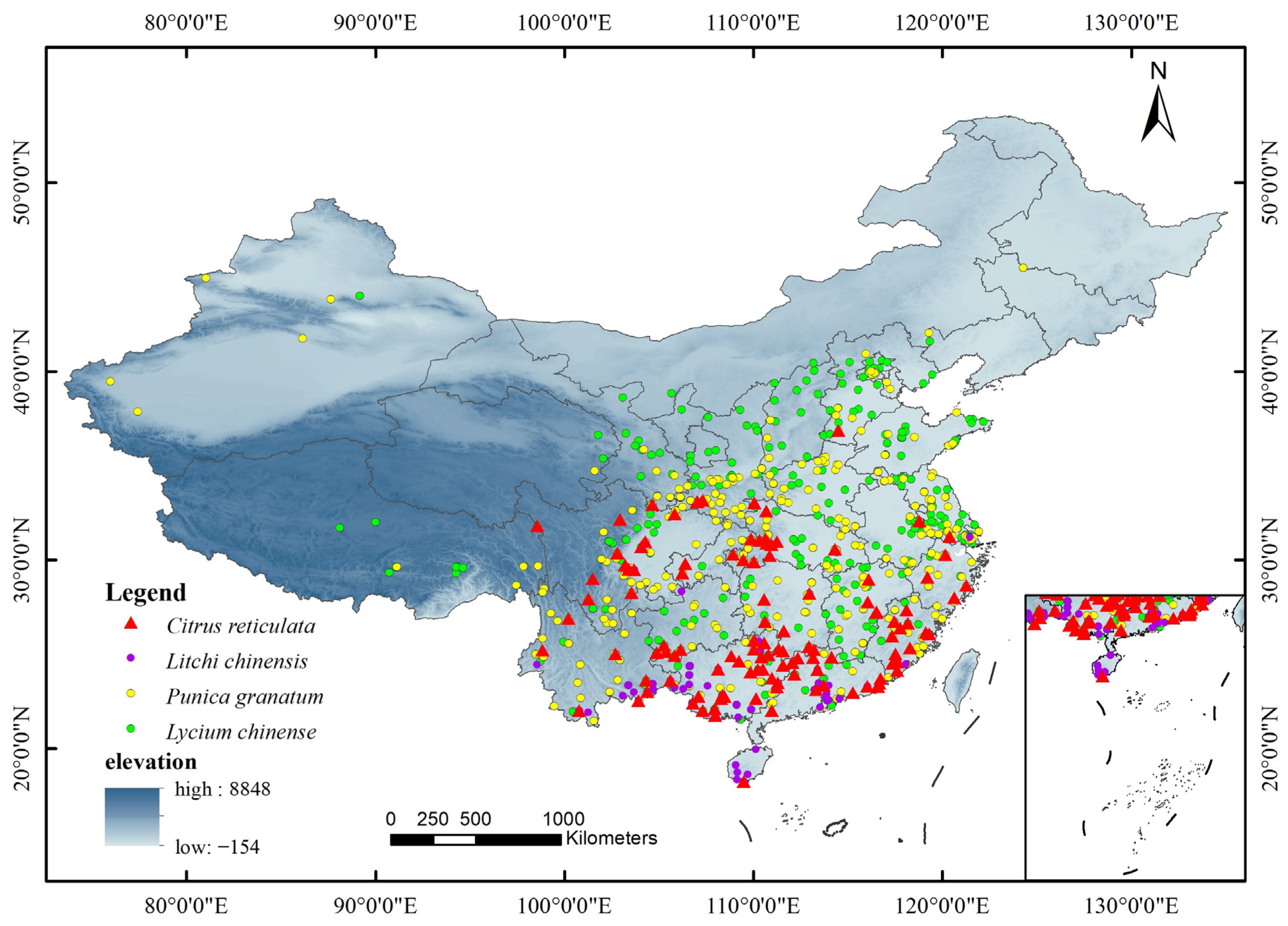

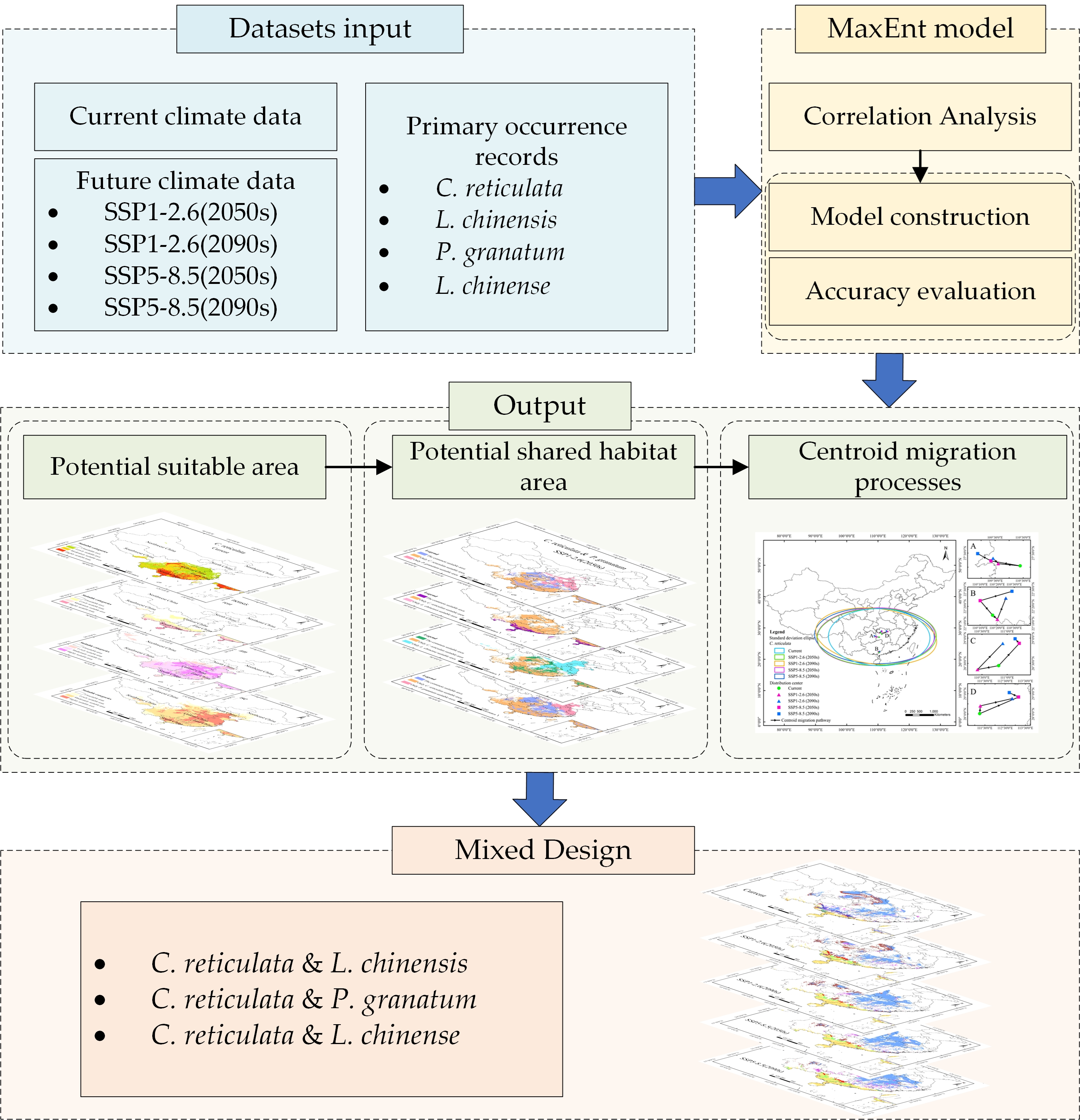
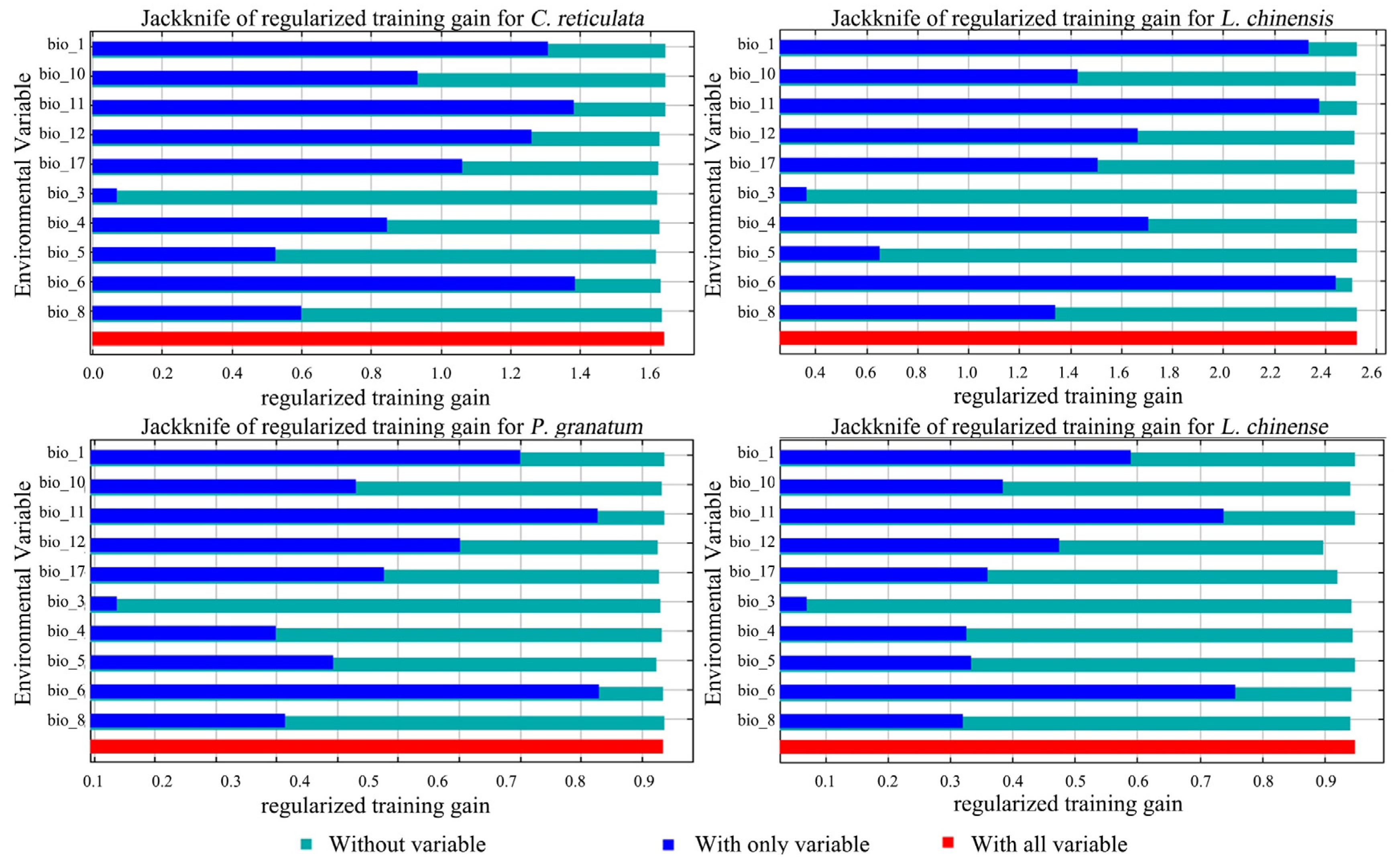
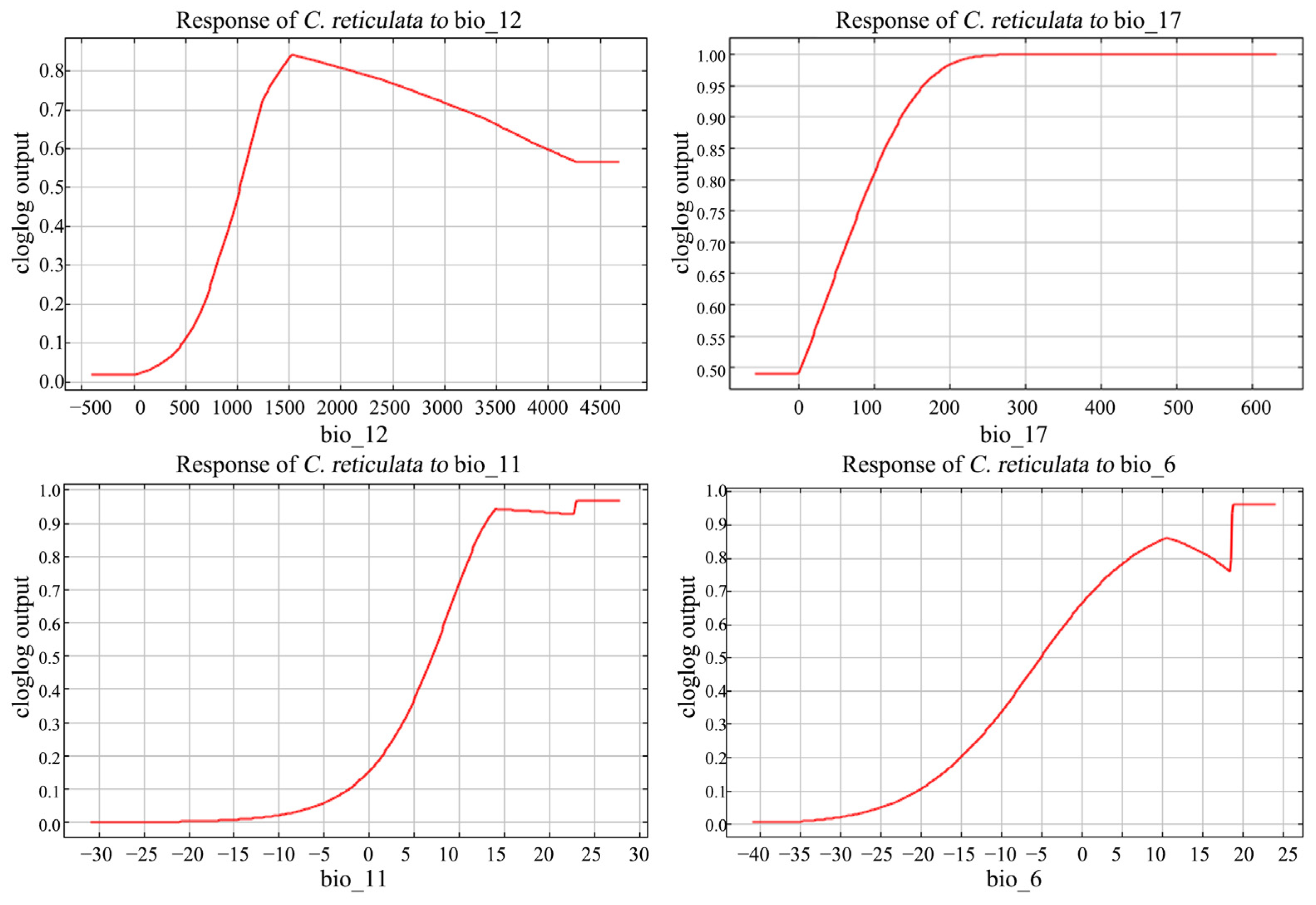
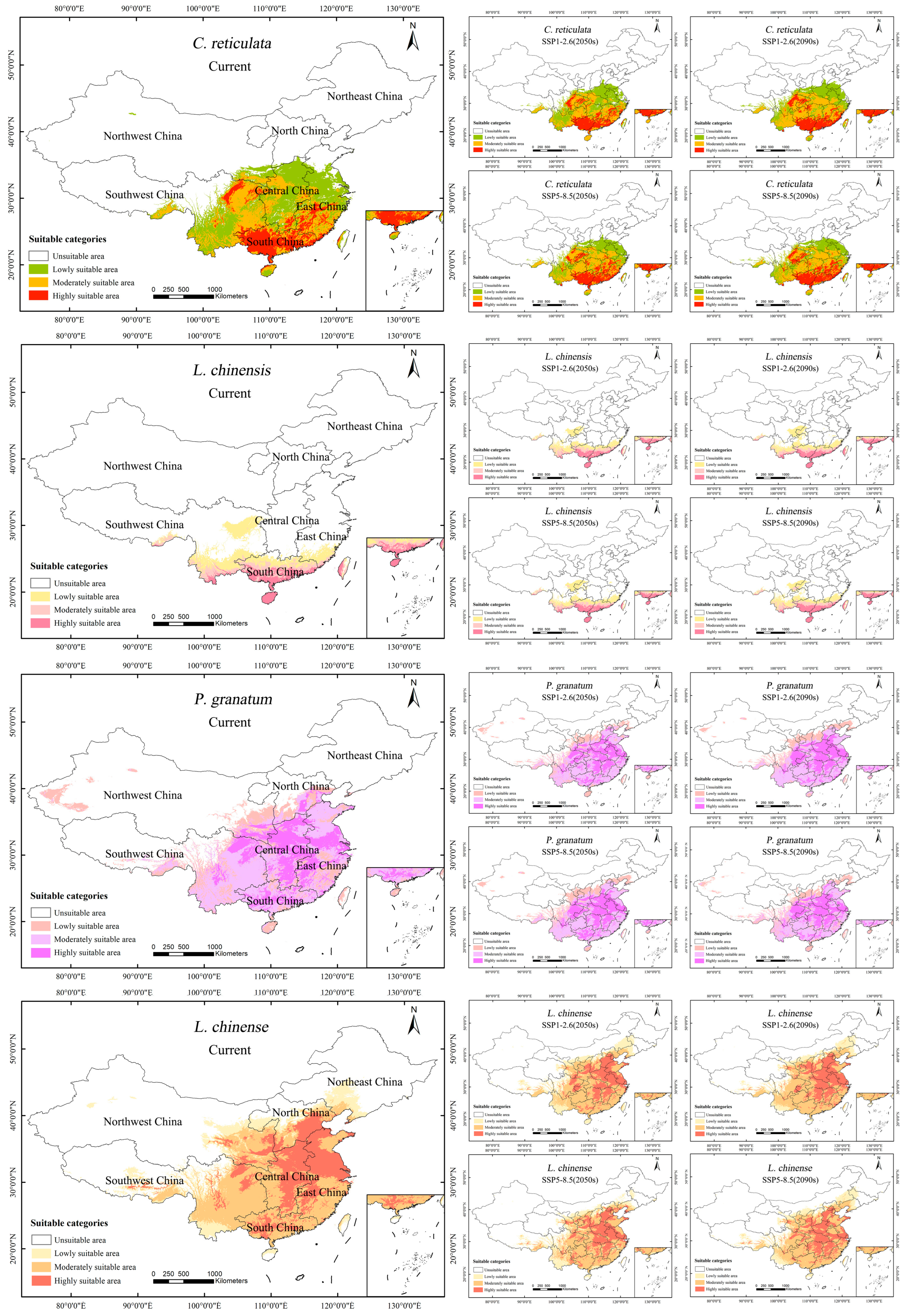

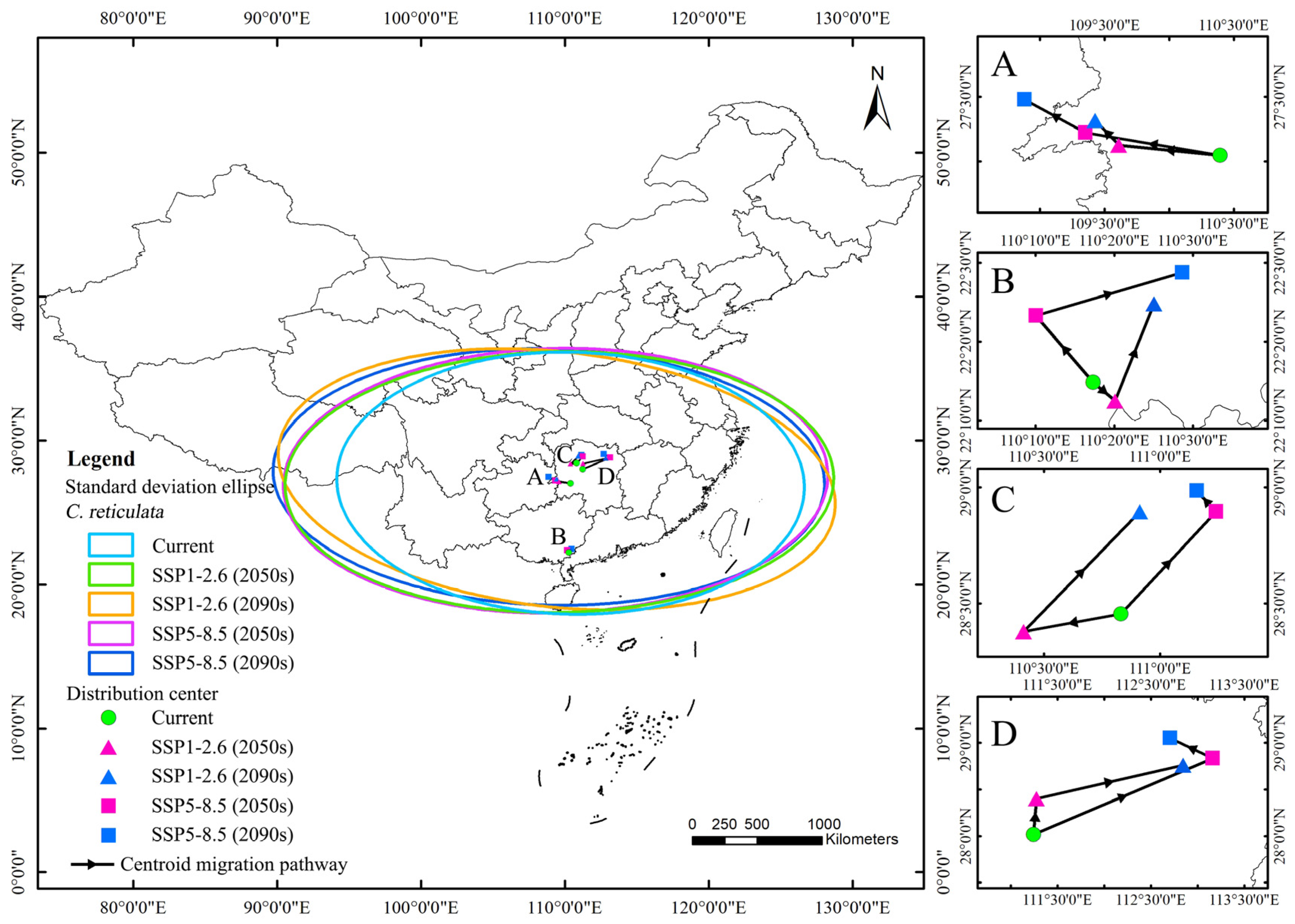
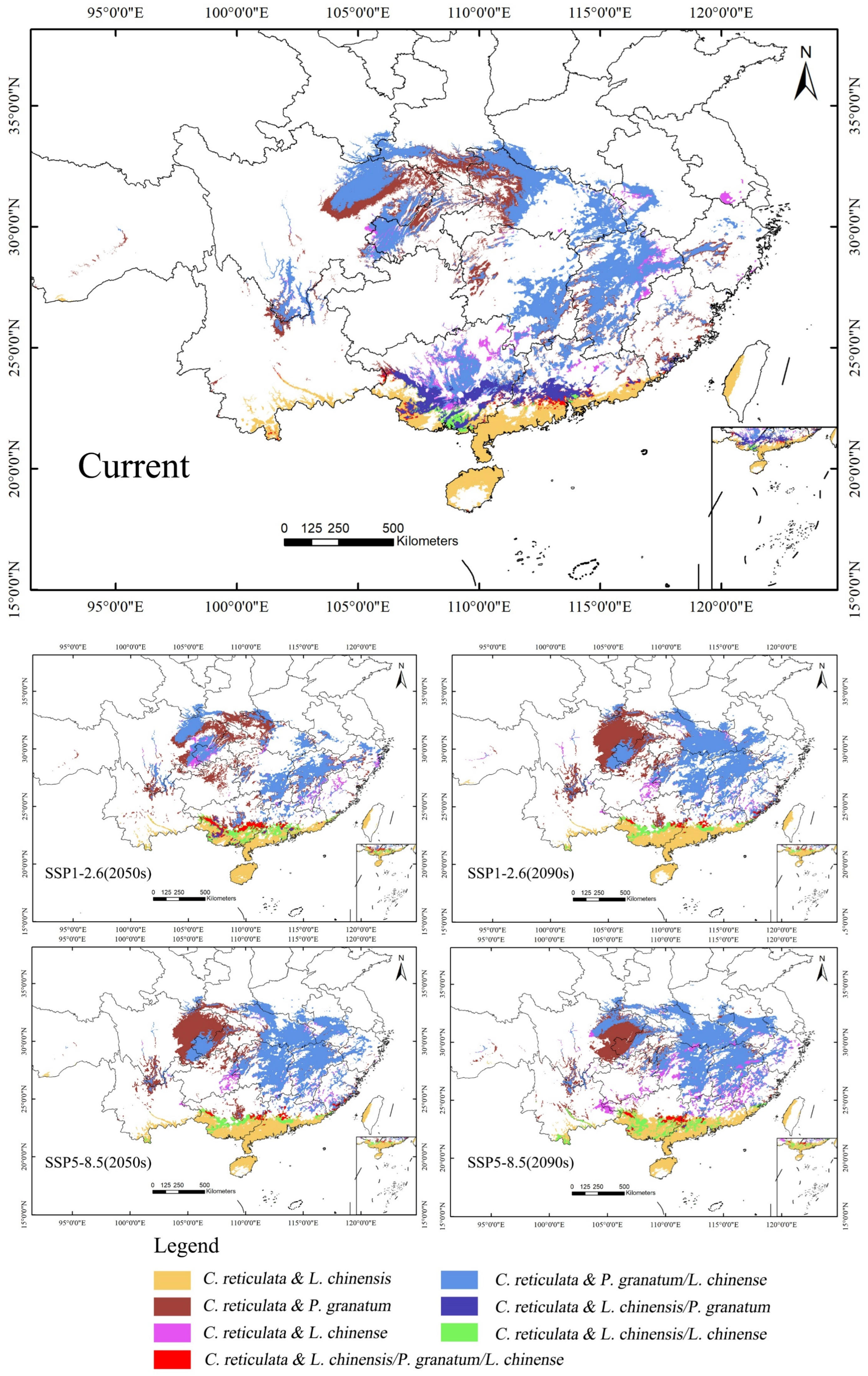
| Data Types | Data Sources |
|---|---|
| Global Biodiversity Information Facility (GBIF) | http://www.gbif.org, accessed on 30 November 2023 |
| The National Forest Continuous Inventory (NFCI) | - |
| Plant Photo Bank of China (PPBC) | http://ppbc.iplant.cn/, accessed on 2 December 2023 |
| China National Specimen Information Infrastructure (NSII) | http://www.nsii.org.cn/, accessed on 2 December 2023 |
| Current climate data | https://worldclim.org/, accessed on 5 November 2023 |
| Future climate data | https://worldclim.org/data/cmip6.html, accessed on 5 November 2023 |
| China yearbook of agricultural price survey (2023) | https://www.stats.gov.cn/, accessed on 12 November 2023 |
| Environment Variable | Definition | Unite |
|---|---|---|
| bio_1 | Annual Mean Temperature | °C |
| bio_2 | Mean Diurnal Range | °C |
| bio_3 | Isothermality (bio_2/bio_7) (×100) | - |
| bio_4 | Temperature Seasonality (standard deviation ×100) | - |
| bio_5 | Max Temperature of Warmest Month | °C |
| bio_6 | Min Temperature of Coldest Month | °C |
| bio_7 | Temperature Annual Range (bio_5-bio_6) | °C |
| bio_8 | Mean Temperature of Wettest Quarter | °C |
| bio_9 | Mean Temperature of Driest Quarter | °C |
| bio_10 | Mean Temperature of Warmest Quarter | °C |
| bio_11 | Mean Temperature of Coldest Quarter | °C |
| bio_12 | Annual Precipitation | mm |
| bio_13 | Precipitation of Wettest Month | mm |
| bio_14 | Precipitation of Driest Month | mm |
| bio_15 | Precipitation Seasonality (Coefficient of Variation) | - |
| bio_16 | Precipitation of Wettest Quarter | mm |
| bio_17 | Precipitation of Driest Quarter | mm |
| bio_18 | Precipitation of Warmest Quarter | mm |
| bio_19 | Precipitation of Coldest Quarter | mm |
| Species | Time Periods | Current | SSP1-2.6 (2050s) | SSP1-2.6 (2090s) | SSP5-8.5 (2050s) | SSP5-8.5 (2090s) |
|---|---|---|---|---|---|---|
| C. reticulata | Training set | 0.939 | 0.939 | 0.927 | 0.934 | 0.928 |
| Test set | 0.942 | 0.890 | 0.928 | 0.906 | 0.902 | |
| L. chinensis | Training set | 0.974 | 0.975 | 0.973 | 0.973 | 0.970 |
| Test set | 0.980 | 0.935 | 0.975 | 0.979 | 0.974 | |
| P. granatum | Training set | 0.906 | 0.899 | 0.877 | 0.881 | 0.899 |
| Test set | 0.882 | 0.900 | 0.892 | 0.901 | 0.897 | |
| L. chinense | Training set | 0.865 | 0.864 | 0.863 | 0.888 | 0.869 |
| Test set | 0.859 | 0.843 | 0.860 | 0.859 | 0.871 |
| Variable | C. reticulata | L. chinensis | P. granatum | L. chinense | ||||
|---|---|---|---|---|---|---|---|---|
| PC (%) | PI (%) | PC (%) | PI (%) | PC (%) | PI (%) | PC (%) | PI (%) | |
| bio_12 | 36.1 | 8.8 | 2.9 | 1.1 | 3.3 | 9.6 | 25.3 | 27.5 |
| bio_17 | 25.2 | 4.8 | 29.4 | 1.1 | 1.4 | 9.8 | 3.6 | 8.7 |
| bio_6 | 10.7 | 49.8 | 10.2 | 94.0 | 35.2 | 6.1 | 58.8 | 37.0 |
| bio_5 | 8.3 | 3.3 | 0.1 | 0.7 | 1.5 | 7.1 | 0.6 | 0.7 |
| bio_1 | 6.5 | 0.1 | 42.0 | 0.0 | 4.3 | 19.9 | 0.7 | 0.1 |
| bio_4 | 5.4 | 17.5 | 8.0 | 2.3 | 4.5 | 25.9 | 5.3 | 5.0 |
| bio_8 | 4.4 | 7.7 | 1.1 | 0.5 | 3.1 | 9.2 | 0.9 | 9.0 |
| bio_3 | 2.6 | 5.3 | 0.9 | 0.0 | 0.6 | 3.1 | 0.9 | 1.6 |
| bio_10 | 0.7 | 0.1 | 0.7 | 0.1 | 0.3 | 0.0 | 1.5 | 2.9 |
| bio_11 | 0.1 | 2.6 | 4.6 | 0.0 | 45.8 | 9.2 | 2.4 | 7.5 |
| Species | Climate Scenarios | Year | Unsuitable Area | Lowly Suitable Area | Moderately Suitable Area | Highly Suitable Area | Total Suitable Area | Percentage of Total Suitable Area |
|---|---|---|---|---|---|---|---|---|
| C. reticulata | Current | - | 721.59 | 111.41 | 84.25 | 44.55 | 240.21 | 24.97% |
| SSP1-2.6 | 2050s | 715.38 | 103.18 | 91.80 | 51.44 | 246.42 | 25.62% | |
| 2090s | 696.39 | 97.72 | 113.32 | 54.37 | 265.41 | 27.60% | ||
| SSP5-8.5 | 2050s | 709.70 | 92.04 | 103.58 | 56.48 | 252.10 | 26.21% | |
| 2090s | 710.42 | 91.14 | 101.29 | 58.95 | 251.38 | 26.14% | ||
| L. chinensis | Current | - | 873.80 | 46.81 | 22.70 | 18.49 | 88.00 | 9.15% |
| SSP1-2.6 | 2050s | 874.12 | 44.01 | 22.74 | 20.94 | 87.68 | 9.12% | |
| 2090s | 869.18 | 48.58 | 20.61 | 23.43 | 92.62 | 9.63% | ||
| SSP5-8.5 | 2050s | 871.14 | 45.95 | 21.99 | 22.73 | 90.66 | 9.43% | |
| 2090s | 865.12 | 47.86 | 23.70 | 25.13 | 96.68 | 10.05% | ||
| P. granatum | Current | - | 643.70 | 77.18 | 151.21 | 89.71 | 318.10 | 33.07% |
| SSP1-2.6 | 2050s | 631.55 | 60.01 | 169.09 | 101.15 | 330.25 | 34.34% | |
| 2090s | 619.70 | 61.71 | 166.26 | 114.13 | 342.10 | 35.57% | ||
| SSP5-8.5 | 2050s | 619.10 | 64.65 | 164.24 | 113.81 | 342.70 | 35.63% | |
| 2090s | 632.57 | 66.38 | 155.03 | 107.82 | 329.23 | 34.23% | ||
| L. chinense | Current | - | 570.09 | 78.92 | 192.74 | 120.06 | 391.71 | 40.73% |
| SSP1-2.6 | 2050s | 559.55 | 91.37 | 197.17 | 113.71 | 402.25 | 41.82% | |
| 2090s | 566.46 | 77.13 | 195.98 | 122.23 | 395.34 | 41.10% | ||
| SSP5-8.5 | 2050s | 574.73 | 87.81 | 185.26 | 114.01 | 387.07 | 40.24% | |
| 2090s | 561.58 | 90.87 | 196.97 | 112.38 | 400.22 | 41.61% |
| Species | Climate Scenarios | Year | Only C. reticulata Suitable Area | Only L. chinensis/P. granatum/L. chinense Suitable Area | The Common Suitable Area | Percentage of Common Suitable Area |
|---|---|---|---|---|---|---|
| C. reticulata and L. chinensis | Current | - | 112.46 | 2.15 | 16.34 | 1.70% |
| SSP1-2.6 | 2050s | 123.05 | 0.75 | 20.19 | 2.10% | |
| 2090s | 146.92 | 2.66 | 20.76 | 2.16% | ||
| SSP5-8.5 | 2050s | 138.98 | 1.65 | 21.08 | 2.19% | |
| 2090s | 136.65 | 1.54 | 23.59 | 2.45% | ||
| C. reticulata and P. granatum | Current | - | 79.24 | 40.15 | 49.56 | 5.15% |
| SSP1-2.6 | 2050s | 90.35 | 48.25 | 52.90 | 5.50% | |
| 2090s | 99.34 | 45.79 | 68.34 | 7.11% | ||
| SSP5-8.5 | 2050s | 89.84 | 43.59 | 70.22 | 7.30% | |
| 2090s | 87.19 | 34.78 | 73.04 | 7.59% | ||
| C. reticulata and L. chinense | Current | - | 87.28 | 78.53 | 41.52 | 4.32% |
| SSP1-2.6 | 2050s | 108.02 | 78.48 | 35.23 | 3.66% | |
| 2090s | 120.57 | 75.12 | 47.11 | 4.90% | ||
| SSP5-8.5 | 2050s | 110.22 | 64.16 | 49.84 | 5.18% | |
| 2090s | 98.20 | 50.35 | 62.04 | 6.45% |
Disclaimer/Publisher’s Note: The statements, opinions and data contained in all publications are solely those of the individual author(s) and contributor(s) and not of MDPI and/or the editor(s). MDPI and/or the editor(s) disclaim responsibility for any injury to people or property resulting from any ideas, methods, instructions or products referred to in the content. |
© 2024 by the authors. Licensee MDPI, Basel, Switzerland. This article is an open access article distributed under the terms and conditions of the Creative Commons Attribution (CC BY) license (https://creativecommons.org/licenses/by/4.0/).
Share and Cite
Yang, X.; Wang, S.; Lu, D.; Shao, Y.; Feng, Z.; Wang, Z. Ecological Adaptation and Sustainable Cultivation of Citrus reticulata by Applying Mixed Design Principles under Changing Climate in China. Remote Sens. 2024, 16, 2338. https://doi.org/10.3390/rs16132338
Yang X, Wang S, Lu D, Shao Y, Feng Z, Wang Z. Ecological Adaptation and Sustainable Cultivation of Citrus reticulata by Applying Mixed Design Principles under Changing Climate in China. Remote Sensing. 2024; 16(13):2338. https://doi.org/10.3390/rs16132338
Chicago/Turabian StyleYang, Xuanhan, Shan Wang, Dangui Lu, Yakui Shao, Zhongke Feng, and Zhichao Wang. 2024. "Ecological Adaptation and Sustainable Cultivation of Citrus reticulata by Applying Mixed Design Principles under Changing Climate in China" Remote Sensing 16, no. 13: 2338. https://doi.org/10.3390/rs16132338
APA StyleYang, X., Wang, S., Lu, D., Shao, Y., Feng, Z., & Wang, Z. (2024). Ecological Adaptation and Sustainable Cultivation of Citrus reticulata by Applying Mixed Design Principles under Changing Climate in China. Remote Sensing, 16(13), 2338. https://doi.org/10.3390/rs16132338








